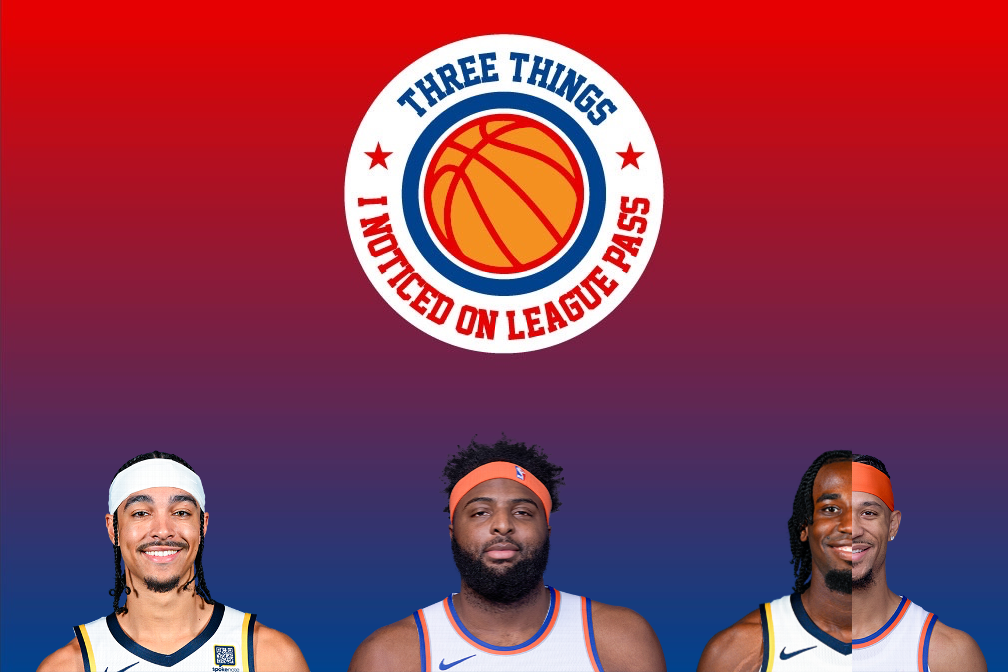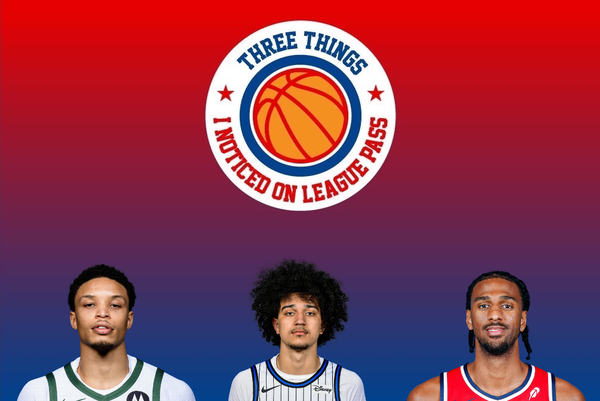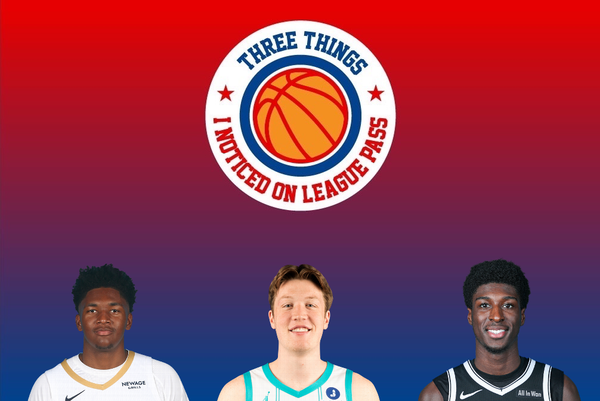Three Things I'm Watching in the Eastern Conference Finals
What to look out for at the Knicks take on the Pacers

Hit the jump for the ECF edition of Three Things, starring backcourt pressure, two-big lineups, and chaos agents.
The Pacers, with pressure
The Pacers have applied pressure on the bring-up ball-handler more often than any other team in the playoffs, according to Second Spectrum, and that's despite the fact that they've played only 10 games — fewer than any other team that made the Conference Finals. They've also appled pressure at least 75 feet from the rim more than twice as often as the next-closest team. Yes, really.
In the series against the Knicks last year, the Pacers ramped things up even further than they have this postseason. They applied backcourt pressure on over 40 possessions per game, picking up ball-handlers an average of 65 feet from the rim when doing so. As a result, they forced the Knicks to consistently initiate their offense with around 14 seconds on the shot clock, which reduced their ability to run multiple actions and forced them into more contested looks than they might otherwise have gotten.
Lots of possessions looked like this:
The Knicks have dealt with more backcourt pressure so far in these playoffs than any other team. They're about to see even more of it against this Pacers team. Andrew Nembhard and Aaron Nesmith and T.J. McConnell are going to try to live inside Jalen Brunson's jersey.
How the Knicks respond to that both on those specific possessions (in terms of efforts to get into their offense more quickly) and throughout the series (in terms of holding up physically) is going to be one of the major battlegrounds on which this matchup is decided. Will they tax Brunson by having him work up the floor against pressure all game long? Will they have Josh Hart or Mikal Bridges handle more offense-initiating duties? And how will their choice impact the series at it gets into the later stages?
The Knicks, with two bigs
We barely got to see Karl-Anthony Towns and Mitchell Robinson play together during the regular season. Hell, we barely got to see Mitch at all. Robinson played just 17 games and 290 total minutes. (In the Knicks' 12 playoff games, he's already played 222 minutes.) As a result, we didn't really know what to expect from the Knicks' two-big lineup. They spent just 47 minutes on the court together, though they did outscore opponents by 11.3 points per 100 possessions in that time.
The playoffs has brought more of the same, but already in twice as much floor time. In 90 playoff minutes, the Towns-Mitch lineups are plus-14.8 per 100 possessions. While they played the Pistons to a dead head across 40 minutes in the first round; in the Celtics series, they outscored Boston by 24 points in the 50 minutes they shared the hardwood. They hammered the glass with a 38.6% offensive rebound rate. Boston went just 14-30 in the paint against the two bigs, shooting just 46% on those looks compared with 56% against single-big lineups. They even finally connected for their first (and only) basket of the season.
And of course, there was the signature end-to-end trip in Game 6:
The Pacers faced two-big units in their previous series against the Cavaliers. With Evan Mobley and Jarrett Allen on the floor together, the Pacers outscored the Cavs by 8 points in 76 minutes after that duo had blitzed the league by 12.2 points per 100 possessions during the regular season. The Cavs did win the battle of the boards, though, corralling 36.3% of their own misses. They also faced two bigs against the Bucks in Round 1, outscoring the Giannis Antetokoumpo-Brook Lopez duo by 32 points in 64 minutes. (Note: I previously misidentified Indiana's first-round matchup as being against the Heat, rather than the Bucks.)
Given how effective it was against Boston, I'd imagine we'll see a lot of the two-big look against Indiana — unless the Pacers successfully counter-act it like they did against their previous two opponents. If they do, it suddenly becomes a much different series.
Nesmith and Hart, cross-matches and chaos
In last year's series, Brunson was cooking Nembhard so badly that the Pacers had to switch his primary matchup to Nesmith. (He scored 72 points on 44 shots in Games 1 and 2. Brunson struggled a bit with Nesmith in Games 3 and 4 before getting going again in Games 5 and 6 and then breaking his hand midway through Game 7.) Most teams these days tend to err toward the side of using size and length to combat Brunson anyway, which makes sense given a) how small he is; and b) how he tends to create space — and if Nembhard isn't viable, that makes Nesmith the best man for the job.
But this year's Knicks team is different. It has Karl-Anthony Towns. (It also has Mikal Bridges and a healthy OG Anunoby.) And the most successful Knick opponents have typically defended Towns with a wing so that they can switch the Brunson-Towns pick and roll without giving up a significant advantage on either end.
Using this strategy has basically neutered the Brunson-Towns pick and roll: During the regular season, New York ran 42.5 Brunson-Towns ball screens per 100 possessions against the Pacers, who guarded Towns mostly with Myles Turner. They ran 27.5 of those ball screens per 100 possessions overall. But in the playoffs, the Knicks have gotten to the Brunson-Towns pick and roll an anemic 17.6 times per 100 possessions. It hasn't quite been taken out of the offense, but it's been minimized in a big way.
As good as Nembhard is, the Pacers would surely be giving up an advantage if they allowed him to consistently switch onto Towns, which may embolden the Knicks to get back to that action more often — even if it means Turner roams away from Josh Hart. Because that's the case, the Pacers are probably better off guarding Brunson with Nesmith and Towns with Pascal Siakam, so that Turner can roam away from Josh Hart and they can switch the Brunson-Towns action. (I do think they'll give it a shot with Nembhard to start, but we'll see how that goes.)
But if Turner's on Hart ... then who is Tyrese Haliburton guarding? Haliburton guarded Hart during the regular-season matchups, but if the Pacers want to replicate the strategy that's had the most success slowing New York's offense, then he has to guard either Mikal Bridges or OG Anunoby. And Nesmith has to be able to switch onto Towns and not get burned, whether by threes or by post-ups. Oh, and Siakam needs to be able to handle Brunson in space, and Towns in the post.
But it sure seems like Nesmith is going to be spending a ton of time defending the Knicks' two best offensive players, and that makes him a huge swing player in the series even before we consider what he brings offensively as a shooter, second-side creator, and offensive-rebound-chaser.
Similarly, Hart is either going to be ignored by Turner or else have Haliburton parked on him as a way-station. The former scenario is probably preferable for the Pacers, because they don't want to give Brunson a way to hunt Haliburton in space.
And whether Hart is going to be ignored (just as he was during the Pistons series and during the Celtics series) or if he's going to be guarded by Haliburton, he has to consistently make the Pacers pay for treating him as an offensive afterthought. He has to be all over the glass and he has to be making plays in the short roll when they do involve him in the action and he has to actually be willing to shoot from deep. He has to be pushing the ball in transition. He has to be everywhere. That's basically his job description to begin with, but this can't be one of those series where he suddenly becomes more hesitant. He has those stretches during the regular season. He can't here.
Depending on how the Knicks match up — which I assume will be with Bridges on Haliburton, Anunoby on Siakam, Hart on Nesmith, Towns on Turner, and Brunson on Nembhard, at least to start — Hart is also going to have one of two difficult tasks: Either he'll be trusted with keeping Nesmith himself off the boards and with not straying too far away from him if and when Haliburton creates advantages in pick and roll or isolation; or else defending Siakam, if the Knicks decide to put Anunoby on Haliburton, as they did with Cade Cunningham and Jayson Tatum.
For what it's worth, I do expect the Knicks to go with Bridges on Haliburton. They got him to take exactly this kind of matchup in exactly this kind of series, and during the playoffs he has defended at exactly the level they expected him to when making the trade, even if he wasn't quite at that level during the regular season. But if Haliburton gets cooking and the Knicks need to re-jigger the matchups, Hart's defense just becomes all the more important.
For discussion of all this and much, much more, check out the latest episode of the Double Dribble podcast with Matt Moore.





